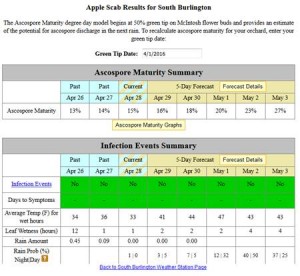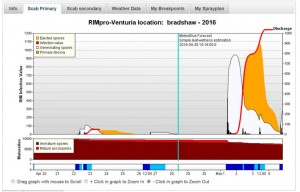By Terence Bradshaw
Art Agnello from Cornell posted the following announcement of NEWA system updates in his latest Scaffolds newsletter:
Many orchards will soon be progressing to the stage where some insecticidal protection is typically needed, so we would take this opportunity to point out the availability of a prediction tool that combines our historical records with the best biological projections we can offer, found on the NEWA Apple Insect Models website. (The site also has pest models for Grapes)
We recently completed some further improvements to this web-based, "Real-Time" Apple IPM
Decision Support System, which can deliver relevant, current information on weather data and pest populations to facilitate grower pest management decisions throughout the growing season. This system tracks seasonal development of fruit bud stage, key insect pests, and diseases using Degree Day and Infection Risk models. The models indicate pest status, pest management advice and sampling options, and are linked to an interactive system that helps growers choose appropriate materials when pesticide use is recommended. Insect pest developmental stages are calculated from Degree Day (DD) accumulations at IPM’s NEWA and National Weather Service airport weather stations throughout NY, MA, VT, NJ, CT, RI, PA, and DE. The insect pests addressed by this website are: apple maggot, oriental fruit moth, codling moth, plum curculio, obliquebanded leafroller, spotted tentiform leafminer, and (NOW also) San Jose scale. Disease predictions are available for apple scab and fire blight, and summer diseases (sooty blotch and flyspeck).
Access to the Apple Insects (and Diseases) models is through the "Pest Forecasts" list or the "Apples" link on the NEWA homepage (http:// clicking on the link that says "Apple Insect Phenology Models and IPM Forecasts" brings up a state map showing the available weather stations, plus pull-down menus on one side. The user selects a pest of interest, state, weather station, and the desired end date for weather data accumulation, and pest DD models and historical records are used to calculate: Tree Phenological Stage, Pest Stage(s), Pest Status, and Pest Management Information, all of which appears on a "Results" page. We have just finished updating the decision points for these advice categories by incorporating the most current 5 years’ worth of temperature/degree day trends, which should result in more precise predictions.
Additionally, the current DD accumulations provided on this page have now been linked to the newly reactivated NEWA Degree Day Calculator so the results are given in the same format used by that tool: a table of the current accumulated heat units, plus the projected values according to NWS 5-day forecast data. A link gives the option of additionally viewing DD progress in graphic form. The phenological stage can be adjusted according to field observations by selecting from a pull-down menu; this will generally change some of text provided in the advice boxes. Links on this page can take the user to various other online resources, such as color photos of the bud development stages, NYS IPM Fact Sheets of the pests in question, and when appropriate, sampling charts for use in conducting field samples of specific pest life stages (e.g., eggs, larvae, mines). When a pesticide spray is recommended, a "Pesticide Information" link in the "Pest Management" box takes the user to the Pest Management Education Program’s (PMEP) Tree Fruit IPM home page, where a pesticide decision filter helps users pick an appropriate material to use, based on anticipated pest severity and program type. A pesticide search returns a series of profiles of all the NY-registered products fitting the specified pest species and efficacy rating. The profile gives the common and trade names, labeled use rate, re-entry and pre-harvest intervals, and EPA registration number of each product. Also included are some general remarks on the range of product efficacy, and any known effects on beneficial species. A "Details" link in each profile box takes the user to a more extensive list of information, including notes on the active ingredient (including its mode of action classification), and an overview of recommended use periods. Predictions provided by the website can be refined and adjusted to reflect current insect activity by user-entered events obtained through field monitoring (such as pest biofix; i.e., the first sustained flight of a pest species). The pesticide selection filter uses Cornell University product efficacy ratings and the type of management program selected by the user (i.e., conventional reduced-risk, non-organophosphate, organic).
This website uses DD information based on either historical records or user-entered biofix data, and includes: the start, peak, or progress of the oviposition/egg hatch/crawler emergence period (for CM, OBLR, OFM, STLM and SJS); the start, peak or end of the pest’s 1st, 2nd, etc., flight (for AM, CM, OBLR, OFM, STLM, and SJS); the first occurrence of adult or larval feeding, foliar or fruit damage, or mines (for OBLR and STLM). An improvement to the site we still plan to implement, in collaboration with a colleague at Penn State, is the incorporation of a least-cost product calculator function, to provide users with an estimate of how much they’ll have to pay for a given pesticide choice.
We are continuing our efforts to refine and improve the accuracy of the website’s pest predictions, and expand the range of sites from which weather data is able to be collected. During this process, we encourage everyone in the apple industry to check this website for themselves throughout the growing season, to see how well it forecasts pest events in specific areas of the state. We appreciate hearing of any anomalies or irregular predictions generated by using the local data to chart pest or disease development in your growing area, and hope to end up with a pest management tool that is useful and accurate for advising apple growers about what’s going on in their orchards in Real Time.



